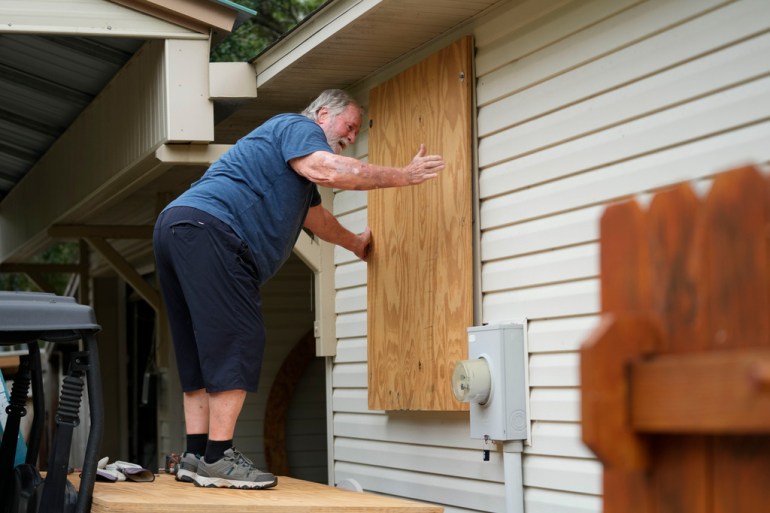Hurricane Helene has rapidly strengthened in the Caribbean Sea while moving north between the coasts of Mexico and Cuba towards the United States, prompting officials to declare an emergency in Florida.
Helene is expected to move over deep, warm waters, fuelling its intensification on Wednesday as it moves north across the Gulf of Mexico, the US National Hurricane Center (NHC) said.
Heavy rainfall was forecast for the southeastern US starting Wednesday, with a “life-threatening storm surge” along the entire west coast of Florida, according to the NHC.
On Wednesday afternoon, Helene was located about 135 kilometres (85 miles) from Cozumel, Mexico, and about 810km (503 miles) south-southwest of Tampa, on Florida’s west coast, as it moved northwest at 17km/h (10mph) with maximum sustained winds of 130km/h (80mph).
The strong winds knocked out power in the Cayman Islands where heavy rain and waves reached as high as three metres (10 feet).
Many in Cuba also worried about the storm, whose outer bands are expected to reach the capital of Havana, which is already struggling with chronic power outages.
Mexico is still reeling from former Hurricane John battering its Pacific coast on Monday and Tuesday, killing two people, blowing tin roofs off houses, triggering mudslides and toppling trees, officials said.
John weakened to a depression after reaching land but then reformed as a tropical storm on Wednesday, and is forecast to make another landfall in the Mexican state of Guerrero, about 155 km (96 miles) north of Acapulco, on Thursday.
Forecast to be a ‘major’ hurricane
Helene is expected to grow into a major hurricane — a Category 3 or higher — on Thursday, the day it’s set to reach Apalachee Bay on Florida’s Gulf Coast, according to the official forecast. The NHC has issued hurricane warnings for part of Mexico’s Yucatan Peninsula and Florida’s northwestern coastline, where large storm surges of up to 4.5 metres (15 feet) were expected.
“It’s going to be a very large system with impacts across all of Florida,” said Larry Kelly, a hurricane specialist at the NHC.
9/25 5am EDT: There is a danger of life-threatening storm surge from Tropical Storm #Helene along the entire west coast of the Florida Peninsula & Florida Big Bend, where a Storm Surge Warning is in effect. Residents in those areas should follow advice given by local officials. pic.twitter.com/EorwuqPfar
— NHC Storm Surge (@NHC_Surge) September 25, 2024
Florida Governor Ron DeSantis issued an emergency for most of the state’s counties, with Helene expected to pass close to the state capital, Tallahassee where local officials worried about major tree damage.
Federal authorities were positioning generators, food and water, along with search-and-rescue and power restoration teams, the White House said.
![A man boards up the windows to his home in advance of Tropical Storm Helene, expected to make landfall as a hurricane, in Ochlockonee Bay, Fla., Wednesday, September. 25, 2024. [Gerald Herbert/AP]](https://www.aljazeera.com/wp-content/uploads/2024/09/AP24269475303370-1727276909.jpg?w=770&resize=770%2C514)
The storm is anticipated to be unusually large and fast-moving, meaning storm surges, wind and rain will likely extend several hundred kilometres from the storm’s centre, the NHC added. States as far inland as Georgia, Tennessee, Kentucky and Indiana could see rainfall.
Some residents along the Gulf Coast in Florida’s Panhandle, are already evacuating to safer areas inland, with memories still fresh of recent storm surge events.
In 2018, Hurricane Michael, struck Mexico Beach about 160km (100 miles) west of where Helene is expected to make landfall. Michael rapidly intensified into a devastating Category 5 hurricane and caught residents off guard, causing an estimated $25.5bn damage and 59 deaths.
In 2023, another Category 3 storm, Hurricane Idalia left as many as 500,000 customers without power after it struck the northwest coast of Florida, also causing major flood damage from storm surge. Idalia was the most powerful hurricane to hit Florida’s Big Bend region since 1950.
Helene is the eighth named storm of the current Atlantic hurricane season, which runs from June 1 to November 30, and the fourth to make landfall in the US. Hurricane Francine struck the Gulf Coast of Louisiana as a Category 2 storm barely two weeks ago.
Since 2000, only three other years besides 2024 have had four or more storms make landfall in the continental US.
This year’s hurricane season coincides with an insurance crisis for homeowners in some US states hit by rising fees and reluctance from private insurers to provide coverage in coastal areas.
The US National Oceanic and Atmospheric Administration predicted an above-average Atlantic hurricane season this year because of record-setting warm ocean temperatures. It forecast 17 to 25 named storms, with four to seven major hurricanes of Category 3 or higher.
But the season is off to a slow start, leaving forecasters searching for factors that may have impeded the formation of major storms as they cross the Atlantic Ocean “hurricane corridor”.








More Stories
Macron urges end to Israeli ‘escalation’ and Hezbollah rocket fire
Donald Trump and Sean ‘Diddy’ Combs television interview video is fake
NTSB engineer says carbon fiber hull from submersible showed signs of flaws